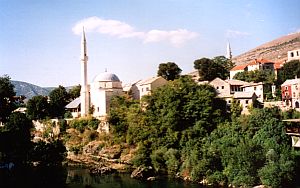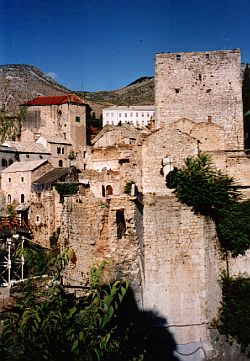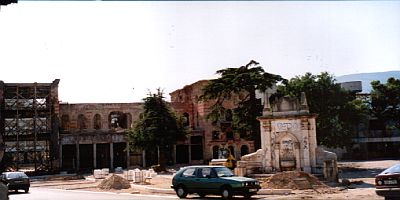Official Name
Mostar. This place includes the Slavic word "most", which means 'bridge'. Together with the ending, the whole name means something like keeper of the bridge. This refers to the old bridge in centre of town built in the 16th century, destroyed during the last war and recently rebuilt.
Location

| ||
| Mostar |
Mostar is around 100 km South of the capital →Sarajevo and only 50 km north of the Adriatic coastline. The city marks the centre of the historical province Herzegovina. The small and clear Neretva river flows from South to North and separates the town into Eastern and Western Mostar. Mostar is surrounded by more-or-less high mountains, among them the 1,967 m high Mt. Botin. The area West of Mostar is mountainous, too. Most mountains are bleak.
Population
Appr. 130,000. Therefore Mostar is the 6th biggest town of the country. This number includes the suburbs - only every second citizen lives in the town itself. In pre-war Mostar, Croats, Serbs and Bosniaks were equally large communities. However, today there are virtually no Serbs at all living in the city.

| ||
| The old Muslim quarter |
Orientation
Beware: All data as of 2001! Mostar is rapidly changing, i.e. some of the information given might be out-of-date!
Mostar is characterised by the steep and narrow valley of the Neretva river and a small tributary. The whole city sprawls in a rather long but narrow valley, which opens to the South, and so most suburbs spread. The left (East) side of the Neretva is the Muslim quarter and shows a strong Turkish influence. Here, countless winding backstreets and mosques etc. dominate the townscape. The main road of this part is called ul. Maršala Tita (Marshal Tito Rd.), running from the South to the North. At the Northern end of the street, Mostar's bus terminal can be found.
The small stretch of land between the Neretva and its tributary as well as a small stretch of land along the right bank is part of the Muslim quarter. The rest is Croatian area. The border between the two parts is clearly defined but not visible. At least it is not supposed to be visible - if the area would not have been the frontline. The former frontline runs along ul. Aleske Šantiać (ul. = rd.) and Blvd. Hrvatskih Branitelja. All buildings along the frontline were reduced to rubble during the war. The Western, Croatian quarter is much more modern. On a big hill in the Southwest, a giant cross had been erected overlooking the whole town. Additionally, a new church with a high tower, probably higher than the minarets in the Muslim quarter, had been built.
History
Mostar was probably founded around the 15th century and developed into a thriving regional centre within the Ottoman empire. However, due to its location Mostar never managed to gain supraregional importance.

| ||
| The destroyed historical bridge (now rebuilt!) |
Maybe because of the lack of strategical importance, Mostar never had been destroyed. And so the remains of the Ottoman past were perfectly preserved. When walking through the town, it feels like being in a small Turkish city. The more recent history is strongly connected to the development of the rest of the country. In 1878, the area became part of the Habsburg monarchy. Since 1918, Mostar and the rest of Herzegovina belonged to the Kingdom of Serbs, Croats and Slovenes respectively Yugoslavia.
Centuries later: After Bosnia-Herzegovina had declared independence in 1992, the JNA (Yugoslavian National Army) seized most of the territory of Bosnia. Fights broke out in the area of Mostar as well. Croats and Bosniaks united and managed to drive out the Serbs including the civilians. But Croats had had other plans. Shortly after the victory, Croats founded the Republik Herceg-Bosna around Mostar and eventually demanded the unification with →Croatia. Mostar was supposed to be the capital of the new republic. And so heavy combats between the former partners errupted. Especially the Muslim quarters suffered massive and permanent shellings. Sadly, this situation culminated in the destruction of Stari Most (Old Bridge), which had been filmed. These images became the symbol of Mostar's tragical history.
Under pressure from outside, both parties agreed on a cease-fire. This didn't mean that the citizens started to live in peace and harmony again, but at least combat actions were stopped. Eversince Mostar is divided into a Bosniak and Croatian part. Everyone can feel free to cross the border, but only a few do. The war has left ugly scars all over the place. There was a ray of hope when the Old Bridge was re-opened in July 2004. Thanks to generous private donations, the bridge could be restored and the re-opening caused quite a hoo-ha. Of course it was a controversial decision - many people argued that the bridge shouldn't be restored to leave the pile of rubble as a warning for generations to come. Maybe it helps to get back to normal life. However, the ongoing contest à la "Who's building the most magnificent House of God" leaves the visitor with doubt.
Getting there / transportation
The train station is a bit out of the way, and there's only route connecting →Sarajevo with Ploče, a small town at the Adriatic coast. I'm not sure whether the route is still active or already discontinued. It's better to stick to buses - there are daily buses to →Dubrovnik, →Split and →Sarajevo. The latter needs two hours, the fare is KM 11.
Personally I looked at Mostar with a mixture of delight and pure horror. In 2001, the latter dominated. The old city centre respectively the Muslim quarter is something I didn't expect in the middle of Europe. But I also didn't expect to see so many ruins. There was almost no building in the Muslim quarter not being bullet-riddled. Some minarets were fallen down. A modern conrete building, probably used as a department store or palace of culture before the war, looked fine from the distance, but on closer inspection it appeared to be completely bombed out.

| ||
| One of the destroyed squares in the centre |
The looted and burnt-down villages South of Mostar is like a writing on the wall and gives an idea what to expect in Mostar. Everything is destroyed - either by shelling or massive gunfire. Especially buildings along the former frontline look very bad, but some apartments inside the destroyed houses are still in use. The area around the bridgehead is particularly nice and somehow very oriental. What else is left from the long Ottoman rule period? South of the centre, the 350-year-old Turkish House can be found. It's more like a museum - the owner is a very friendly man who loves to explain everything about the Ottoman history and Turkish habits.

| ||
| At the frontline: some appartments are still in use |
About the above-mentioned Stari Most (Old Bridge): The narrow crooked bridge was built by an Ottoman architect, which is quite obvious, in 1566. In November 1993, the old bridge fell victim to mortar shelling from the Croatian side. Today, t-shirts showing images of the bridge plunging into the Neretva are sold in souvenir shops near the bridge. Surely a matter of taste. The bridge was already a symbol of Mostar before the war and became a symbol of the absurd war in 1993. Therefore, the reconstruction of the bridge was just a question of time. There was an even older bridge nearby. Unfortunately, the second bridge was washed away by a flood in 1999.
The best thing to do in Mostar is to slowly walk around the old city centre, called Kujundžiluk. Cobbled streets, some mosques and old stone houses from around the 16th century are definitely worth a visit - for people being interested in history as well as for everyone else. It can be expected that many buildings have been restored since 2001.
The area around Mostar looks like a perfect place for hiking. We didn't - destroyed villages gave us the idea that there might be mines and UXOs. 25 km South of Mostar is the formerly very small village of Međugorje. In 1981, six youths reported an apparition of the Holy Virgin. Eversince, the village developed into a famous place of pilgrimage. Today, more than 17,000 hotel beds cater for the visitors. The war never came to Međugorje.
Opposite the bus terminal, the Pansion Sator is quite good. It's a bit hard to find - cross the street in front of the bus terminal, walk around 200 m to the left. It's on the 2nd floor of a green building. The family is very funny and atmosphere is much better than in any hotel. The double costs KM 50 (=25 each). Address: ul. Maršala Tita 40.
- www.mostar.ba: Official website of Mostar. Instead of creating almost identical Bosnian and Croatian versions, they should rather write an English version!
- www.menzel-hilbersdorf.de/mostar German travel report with loads of pictures.
Do you have or do you know a good website about Mostar? Don't hesitate, let me know! After checking it, I would love to add it to the link list. You can submit a link by using the →contact form. Note that commercial websites will be treated differently.
©2024 Europe-East.com

 Albania
Albania Bosnia
Bosnia